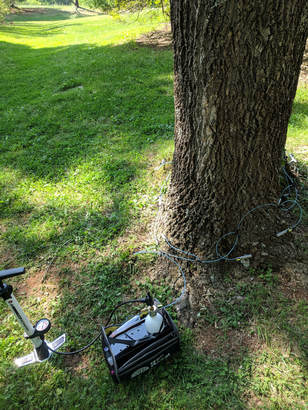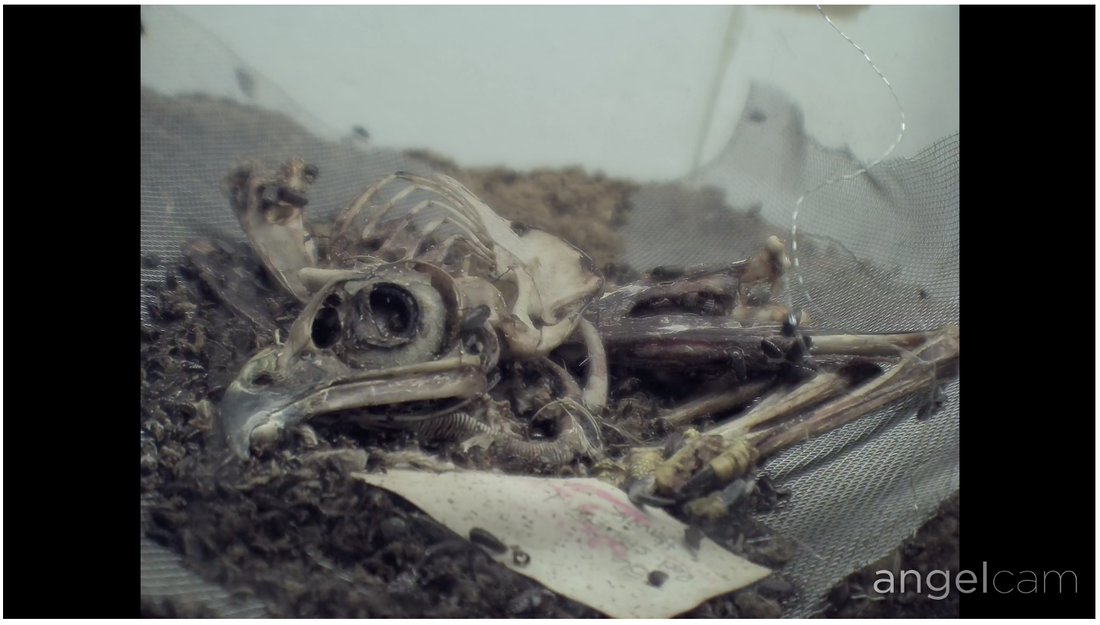 Injection system for protecting trees from Emerald Ash Borer. Photo by VDOF.
Injection system for protecting trees from Emerald Ash Borer. Photo by VDOF.
VDOF offers an ash treatment cost-share program to encourage landowners and organizations to chemically protect specimen ash trees in order to safeguard a core surviving population of ash from the devastation caused by the emerald ash borer. Any native ash tree measuring 12 inches or larger in diameter and displaying 30% or less crown dieback qualifies for treatment. Individual landowners are reimbursed 50% of the total cost of treatment, up to $1250. Organizations (i.e. non-profits, HOAs, universities, municipalities, etc.) are also encouraged to participate and can be reimbursed up to $5000. In 2018, we successfully cost-shared 107 projects treating 547 ash trees across 27 counties. The cost-share will be available once more in 2019.
While chemical control is necessary to protect specimen ash trees, biological control is a potential long-term solution to preserve ash in forested settings. Four species of tiny stingless parasitoid wasps have been approved for release as biological control of EAB and this year VDOF released three species of parasitoid wasps at four sites- two state forests and two wildlife management areas. Two to three rounds of parasitoids were released per site, for a total of approximately 2,000 females per site. The three species released have been thoroughly tested and quarantined by the USDA-APHIS to ensure they do not have significant non-target effects. Once parasitoid populations increase and become established, they can parasitize 50-90% of EAB larvae present. We hope someday these agents will be able to control EAB populations and facilitate ash regeneration on Virginia’s forested lands.
For more information about EAB, visit emeraldashborer.info. If have an ash tree on your property and would like details about the VDOF ash treatment cost-share program, please contact Meredith Bean (EAB Coordinator) via Phone: 434-220-9034 or Email: meredith.bean@dof.virginia.gov.
The Virginia Tobacco Region Revitalization Commission (TRRC) recently awarded a $75,000 grant to the Virginia Museum of Natural History Foundation for construction of the VMNH Outdoor Education Pavilion, a multi-use covered structure with exhibit materials interpreting the natural features and forest ecology of adjacent J. Frank Wilson Memorial Park.
The pavilion will be a multi-season covered structure, with flexible-use outdoor seating and a variety of exhibit materials highlighting the natural elements and forest ecology of nearby J. Frank Wilson Park. The pavilion will serve as a venue for outdoor education programs, special events, café seating, and rentals by outside individuals and organizations.
The $75,000 in TRRC support represents 50 percent of the overall project cost of $150,000, with matching support being sought through individual, corporate and foundation support.
Sometimes, science smells like death: Flesh-eating beetles the stars of Virginia Museum of Natural History’s 24/7 live video stream
“What’s that smell?” A question that never has a pleasant answer. Within the most far-flung reaches of the Virginia Museum of Natural History, it’s a question that has been asked many times. The answer is not for the faint of heart. A colony of flesh-eating beetles resides at the museum, constantly feasting on the remains of animals – all in the name of science. Now, every minute of the gruesome process can be viewed on the museum’s website via a continuous live feed.
The museum’s dermestid colony is so effective at removing the soft tissue from deceased animals that, within just a few days – or weeks for very large animals – there will be nothing but a skeleton remaining.
Enter Liberty Hightower, museum research technician and overlord of the museum’s dermestid colony since 2014. Hightower and her colony of beetles are responsible for providing the pristine skeletal remains of animals for the museum’s research collections through the grisly process of devouring flesh. Of course, Hightower, herself, does not eat the flesh.
“After I record important data from the animal, such as sex, body length, tail length, and other characteristics, the animal is skinned and gutted,” said Hightower. “Tissue samples are sometimes taken of the muscle, heart, kidney, and liver and stored in vials frozen for later DNA analysis. In large specimens that would start to decay and mold before t
he process is complete, I take off large portions of muscle, leaving only a small amount on the carcass. This meat is saved for times when the colony is hungry and there are no specimens in need of cleaning. When that happens, I make jerky strips out of the meat and give them to beetles until there is a carcass in need of cleaning. The specimen is dried to a jerky-like firmness to inhibit mold growth in the warm, humid beetle tanks and then given to the beetles. The carcass is kept on screen mesh or in a tray so that not even the smallest bones are lost.”
For many people, such job responsibilities aren’t high on their wish list, but for Hightower, it’s business as usual.
“Truly, this job is amazing,” said Hightower. “While it’s stinky and really warm in the dermestid room, I’m constantly amazed at how well the beetles do their job. The tiniest crevice or hole in a bone is completely cleaned by them. When the colony is really active, they can be given a mouse whole – without skinning or gutting the specimen – and finish it in a single day. One would imagine it might become a boring or routine part of my job, but it never ceases to astonish me how they can transform a carcass into a pile of white bones!”
Hightower notes that the cleaned skeletal remains are not only used in the museum’s mammalogy (study of mammals) and ornithology (study of birds) collections, but they are also often used in the museum’s archaeology comparative reference collection.
“Archaeologists use these skeletons to identify unknown bones found at archaeological sites,” said Hightower. “By comparing an unknown to a known, archaeologists can readily identify the animal it came from. This allows for inferences to be made on the behavior of people from that time, such as what they were eating and hunting.”
So, what happens if Hightower accidentally falls into the colony? Fortunately, the beetles are only interested in dead things, but that’s not to say the job doesn’t come with occupational hazards.
“The colony does pose a potential health hazard in that the hairs of the larva, as well as the frass (science-speak for “bug poop”), can irritate the respiratory system,” said Hightower. “Many people develop an allergy to them after working with them for a few years. This is why, if I am doing more than just throwing them some jerky straps, I wear a respirator or face mask and gloves when I go into the dermestid room. This is especially important when I am pulling skeletons, as that process requires me to disturb the frass layer.”
Hightower also notes that she, nor anyone else, hunts prey for her colony. All animals fed to the beetles are salvaged.
“The museum holds a salvage permit from the Virginia Department of Game and Inland Fisheries to salvage any animal remains found dead,” said Hightower. “Usually, the animals we acquire have been hit by cars or killed by cats.”
The continuous live feed of the dermestid colony can be found on the museum’s website at www.vmnh.net/dermestid-cam. For more information about the museum, including its scientific programs, visit www.vmnh.net.
Virginia Museum of Natural History receives $97,637 grant from Institute of Museum and Library Services
The Virginia Museum of Natural History recently received a grant of $97,637 from the Institute of Museum and Library Services (IMLS) to improve the care and accessibility of approximately 200 to 540 million-year-old geologic rock core that documents the extent and characteristics of the largest uranium deposit in the United States. Recent considerations of mining the uranium deposit have resulted in increased requests for access to the rock core collection, requiring additional measures to ensure its future health and accessibility.
The collection consists of 75,000 linear feet of 2-inch rock core drilled from Triassic (approximately 252 – 201 million years ago) and Paleozoic (approximately 541 – 252 million years ago) rocks in the Virginia Piedmont.
More than just a science-based need, the overall project will have a positive economic impact for the region, with project funding to support Virginia-based contractors and suppliers.
The grant was awarded to the museum through the IMLS “Museums for America” program, which supports projects that strengthen the ability of an individual museum to serve its public. The “Museums for America” program has three project categories: Lifelong Learning, Community Anchors and Catalysts, and Collections Stewardship and Public Access.
Upcoming Virginia Museum of Natural History family festivals
- January 19, 2019 – Reptile Festival (Student Day Jan. 18)
- June 15, 2019 – Bug Festival
- July 26-27, 2019 – Dino Festival


